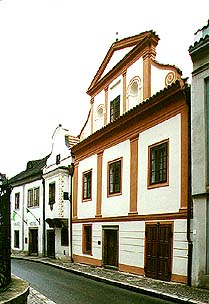Horní No. 147
Description of the Building:
This one story building was built on the mild slope of Horni
Street. The main facade of the structure which faces Horni Street
is topped off by an early -Baroque scrolled gable wall, which is
broken up by two small niches that each have a coquillege at the
top. Above each of these niches is a triangular tympanum. At the
ground floor and first floor levels, the facade is sub-divided
vertically by engaged Doric columns and horizontally, between the
ground and first floors, by molded stringcourses. On the left side
of the interior of the ground floor, there is a hall with segmented
barrel vaults, which were additionally subdivided by the
construction of separating walls. In the center of the building
there are additional vaulted areas. The rooms in the back section
of the building have flat ceilings. Though the majority of the
ceilings on the first floor are flat, some are coffered in stucco
with a square design. On the back side of the building there is a
wooden balcony. Extensive, original Gothic, cellar space remains
underneath the entire building.
Architectural and Historical Development:
The core of the building is Gothic and the original layout can best
be seen in the cellars, where it has remained well-preserved. The
back section of the building was annexed on to the original
structure and the original layout of the ground floor was
remodelled in the Renaissance era. Further alterations, including
the construction of the decorative gable, occurred in the
early-Baroque period. During Classical renovations, the layouts of
the interior on the ground and first floors were reconfigured and
the stucco square designs on the ceilings in parts of the interior
were created.

|

|
Significant Architectural Features:
Early-Baroque gable wall on the facade
History of the House Residents:
The first known resident of the building was a carriageman named
Matej in the beginning of the 16th century. Petr the weaver and his
wife Dorota were the next owners of the building from 1510.
Succeeding them was another weaver named Jan Stubenvoll. After his
death, his widow Katerina was remarried to Jan Kyczhaypla and the
two lived together until his death. Katherina then sold the
building to town clerk Bernard Kozarec. After his death, his widow
Magdelena and four children stayed in the building. Magdelena was
remarried to an organist named Sebastian in 1578, and they remained
in the building until 1581, when it was sold to a cobbler named
Jakub Stehauf. Stehauf lived here with his wife and three children
until 1599, when the building was purchased by Florian Flanders,
who was also known as Pinus. His family lived here until 1639. The
baker Valentyn Fischer lived in the building from 1639, and after
him, a town miller named Ondrej Schanerle lived here until his
death in 1666. Chief administrator of the clergy Gabiel Michal,
bought the building from Schanerle´s widow in 1743. It is suggested
that the owner of the building in 1767 was the retired town clerk
Kristof Fiedler. From 1786, the building belonged to the Neumuller
family, whose members include a hat maker and a ribbon maker.
Present Use:
Segeš Exklusive
Rubín
Apartment
in Horní Street No. 147


